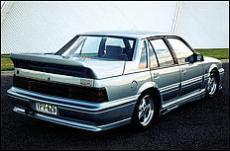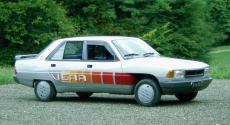Sourcing Information
Over the years I’ve spent a lot of time in TAFE libraries (for those not living in Australia, technical college libraries). In addition to the very valuable automotive books, it’s the engineering papers that are the most interesting.
Each year the Society of Automotive Engineers publishes numerous technical papers on all topics automotive. You can buy them as downloadable pdfs by going to www.sae.org – but because you can see only a précis of the paper before you need to get out your credit card, this can be an expensive way of acquiring information. However, technical college libraries often have some of the papers, especially in the book form that the SAE occasionally publishes.
The ability to keep on the cutting edge of change is one clear advantage of the SAE engineering papers, but there’s another major advantage that’s often overlooked. And what’s this other advantage? If you own an older car, it’s possible by consulting the papers of that era to find stuff that’s directly relevant to your machine.
 In 1990, when I owned a VL Holden Commodore Turbo, I was frustrated by its lack of aerodynamic development. The standard car was lousy and there were no simple off-the-shelf improvements available. The HDT Brock Commodores had body kits developed with no scientific input, and the pictured groundbreaking ‘Walkinshaw’ Group A, the first HSV model and one shaped with a huge amount of wind tunnel work, was too expensive to buy. (And it didn’t have the turbo engine.) And because the Walky was a near new car, you also couldn’t buy copies of its body kit.
In 1990, when I owned a VL Holden Commodore Turbo, I was frustrated by its lack of aerodynamic development. The standard car was lousy and there were no simple off-the-shelf improvements available. The HDT Brock Commodores had body kits developed with no scientific input, and the pictured groundbreaking ‘Walkinshaw’ Group A, the first HSV model and one shaped with a huge amount of wind tunnel work, was too expensive to buy. (And it didn’t have the turbo engine.) And because the Walky was a near new car, you also couldn’t buy copies of its body kit.
The primary trouble with the VL – it was the first car I ever wool-tuft tested on the street, still and video cameras in action – was its rear end. The boot was too low, and the rear window angle too steep, to give attached flow to the end of the car. Instead, the airflow separated at the end of the roof and the rear window and boot lid were a mass of turbulence. (Of course, that’s why the Walky had the raised boot lid.)
So where could I go for help? Nowhere – until I discovered a tech paper on the development of the Peugeot ‘VERA’. It’s now so long ago that the tech paper – that I still have – has lost its cover page, so I don’t know if it was published by the SAE or some other organisation. But I do remember my absolute joy in finding it and applying its ideas to the Commodore.
You see, the thing that made it relevant is that VERA was a developmental vehicle that tried to optimise a Peugeot 305 three-box sedan for aerodynamics, all by using just add-ons. In other words, it was a car where the fundamental glass-house and panels were not to be changed. And VERA was stunningly successful, with the measured drag co-efficient dropping from the standard car’s 0.44 to just 0.31. Front-end lift was also reduced – in fact, front down-force was created.
The paper details different front and rear spoilers, wheel fairings, deletion of glass mouldings, changes in engine bay cooling drag, side window deflectors, sealing of front-end gaps, venting of front wheel arches – and a whole lot of other stuff, most of which could also be applied to my Commodore which had a very similar rear window angle and effective boot-lid height.
At the time, it was a lot of fun playing around with the ideas that the engineering paper gave me.
I’d forgotten most of this until I bought my Peugeot 405. One day I was looking at the car in profile and I suddenly realised it reminded me of that old VERA-version 305. I dug out the tech paper and it’s clearly obvious that Peugeot used some of the aero lessons from that development car in the later model. And while I had the paper in hand, I read it through again – and it’s really very good (in fact, perhaps the best ever published) on improving the aerodynamics of a ‘traditionally’ shaped car.
So if you have an older car, keep in mind that there’s a major resource available in the shape of the engineering papers written when your car was current.
 PS: I couldn’t resist doing a web search to see if I could find a pic of VERA – and here it is. And when I saw the pic I spotted something else I’d not since realised – the front wheel arch venting looks very similar to the approach taken on my Honda Insight (one of the world’s slipperiest cars)… so maybe plenty of others also read that seminal paper.
PS: I couldn’t resist doing a web search to see if I could find a pic of VERA – and here it is. And when I saw the pic I spotted something else I’d not since realised – the front wheel arch venting looks very similar to the approach taken on my Honda Insight (one of the world’s slipperiest cars)… so maybe plenty of others also read that seminal paper.

 Julian Edgar, 50, has been writing about car modification and automotive technology for nearly 25 years. He has owned cars with two, three, four, five, six and eight cylinders; single turbo, twin turbo, supercharged, diesel and hybrid electric drivelines. He lists his transport interests as turbocharging, aerodynamics, suspension design and human-powered vehicles.
Julian Edgar, 50, has been writing about car modification and automotive technology for nearly 25 years. He has owned cars with two, three, four, five, six and eight cylinders; single turbo, twin turbo, supercharged, diesel and hybrid electric drivelines. He lists his transport interests as turbocharging, aerodynamics, suspension design and human-powered vehicles.

on November 22nd, 2007 at 11:21 am
The university of qld in brisbane has all the SAE papers from about 1946 to 1990 sitting on the shelf in the engineering library.
Part of why my degree took me so long…. 🙁
on November 22nd, 2007 at 1:16 pm
According to this list,
http://en.wikipedia.org/wiki/Automobile_drag_coefficients
the Honda Insight has a Cd of .25 which I think is amazing considering most supercars usually compromise towards aerodynamic efficiency over practicality are mostly above .32.
on November 22nd, 2007 at 1:20 pm
But supercars aim to have low lift (or negative lift) and that increases drag.
on November 22nd, 2007 at 1:48 pm
Then why do F1 cars (that generate huge amounts of downforce) range between Cd 0.7 and 1.1 if negative lift increases drag?
on November 22nd, 2007 at 1:50 pm
Um, they have high drag because they have high downforce. Isn’t that what I said?!
on November 22nd, 2007 at 2:00 pm
Yup, sure is.
Hmm, I’ll crawl back into my hole now.
on November 23rd, 2007 at 1:31 am
Is this the paper? (http://www.sae.org/technical/papers/845135) I’d be interested in getting it to have a read if its the one you are recommending.
on November 23rd, 2007 at 5:31 am
No that’s not the paper